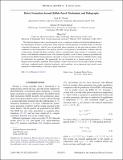Defect Formation beyond Kibble-Zurek Mechanism and Holography
Author(s)
Chesler, Paul M.; Garcia-Garcia, Antonio M.; Liu, Hong
DownloadLiu-2015-Defect formation.pdf (1.085Mb)
PUBLISHER_CC
Publisher with Creative Commons License
Creative Commons Attribution
Terms of use
Metadata
Show full item recordAbstract
We study the dynamic after a smooth quench across a continuous transition from the disordered phase to the ordered phase. Based on scaling ideas, linear response, and the spectrum of unstable modes, we develop a theoretical framework, valid for any second-order phase transition, for the early-time evolution of the condensate in the broken phase. Our analysis unveils a novel period of nonadiabatic evolution after the system passes through the phase transition, where a parametrically large amount of coarsening occurs before a well-defined condensate forms. Our formalism predicts a rate of defect formation parametrically smaller than the Kibble-Zurek prediction and yields a criterion for the breakdown of Kibble-Zurek scaling for sufficiently fast quenches. We numerically test our formalism for a thermal quench in a (2 + 1)-dimensional holographic superfluid. These findings, of direct relevance in a broad range of fields including cold atom, condensed matter, statistical mechanics, and cosmology, are an important step toward a more quantitative understanding of dynamical phase transitions.
Date issued
2015-05Department
Massachusetts Institute of Technology. Center for Theoretical Physics; Massachusetts Institute of Technology. Department of PhysicsJournal
Physical Review X
Publisher
American Physical Society
Citation
Chesler, Paul M., Antonio M. Garcia-Garcia, and Hong Liu. “Defect Formation Beyond Kibble-Zurek Mechanism and Holography.” Physical Review X 5, no. 2 (May 2015).
Version: Final published version
ISSN
2160-3308